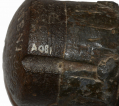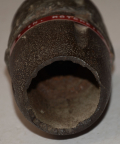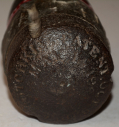site search
online catalog
FIRED U.S. 3” HOTCHKISS CASE-SHOT

$895.00 SOLD
Quantity Available: None
Item Code: 490-7002
Offered here is a very nice excavated Union artillery shell that was fired and, partially, detonated. This is an iron, 3” Hotchkiss artillery shell that was intended to be fired from a 10-pounder Parrott rifle or 3” Ordnance rifle.
This shell is made up of three separate sections. The nose section would have been filled with lead case-shot balls and the explosive charge. When this was fired, the fuse and top blew straight out as designed to direct the lead balls. Because of this hole created in the nose, a view of the interior construction shows a square nail sticking up from the bottom. This was critical in the casting process.
However, the remainder of the shell did not fragment for some reason. The middle section, a lead sabot, is intact and shows rifling marks very well. The third section is the iron base cup. On the bottom of this cup is the very clearly visible Hotchkiss patent information as cast into the piece. This is the type with three flame grooves running up the sides.
This item was excavated so the exterior iron surface is brown and rusty, but is not heavily pitted.
This shell is an excellent display piece or educational tool, as well as an excellent addition to any excavated Civil War artillery or general relic collection. [jet][ph:L]
~~~~~~~~~~~~~~~~~~~~~~~~~~~~~~~~~~~
THIS ITEM, AS WITH ALL OTHER ITEMS AVAILABLE ON OUR WEB SITE,
MAY BE PURCHASED THROUGH OUR LAYAWAY PROGRAM.
CLICK HERE FOR OUR POLICIES AND TERMS.
THANK YOU!
Inquire About FIRED U.S. 3” HOTCHKISS CASE-SHOT
For inquiries, please email us at [email protected]
Most Popular
Historical Firearms Stolen From The National Civil War Museum In Harrisburg, Pa »
Theft From Gravesite Of Gen. John Reynolds »
Selection Of Unframed Prints By Don Troiani »
Fine Condition Brass Infantry Bugle Insignia »
British Imported, Confederate Used Bayonet »
Scarce New Model 1865 Sharps Still In Percussion Near Factory New »
featured item
OFFICER’S FROCK COAT OF BREVET MAJOR GENERAL JOSEPH K. BARNES, SURGEON GENERAL OF THE U.S. ARMY 1864-1882
This would be the centerpiece of any medical collection: the Major General’s frock coat of Surgeon General Joseph K. Barnes. Barnes was born in Philadelphia in 1817, studied medicine at Harvard, under US Navy Surgeon General Harris, and received… (1179-579). Learn More »
site search
Upcoming Events
APRIL 12-13: SPRING GETTYSBURG MILITARY ANTIQUES SHOW; All Star Events Complex Learn More »







